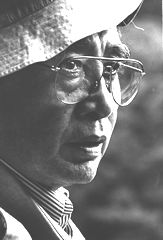
|
 |
 |
 |
|
Yanagisawa
Hisao
Yanagisawa Hisao was born in 1916 in Gunma, Japan. He joined Shochiku
Studios in Kyoto to work on feature films but in 1944 after seeing
Kamei Fumio's Kobayashi Issa (1941) he switched to documentary
filmmaking. Until 1968 he worked at such places as Nippon Eigasha
and Iwanami Productions mostly on industry publicity films. After
1968 he made a number of films on the lives and tribulations of the
disabled which pose fundamental questions about the meaning of human
freedom. In recent years he had begun work on a film about nurses
but passed away on June 16th of this year at the age of 83. Yanagisawa
took part in every YIDFF since the first one in 1989. His contributions
to the festival included serving as a Juror for the Asia Program at
YIDFF '93. His connection to this festival has been a deep and
meaningful one and his absence will be sadly felt.
 |
I Can't Bring Myself to Mourn Yanagisawa Hisao!
Shirai Yoshio
In order to mourn the documentary filmmaker Yanagisawa Hisao, I have
no doubt it would take at least the space of a book. In particular,
how to get down the qualities of thirty years of work that so conscientiously
produced the five films about the group home, Children Before the
Dawn, Night and Morning Inside Myself, Not This Way But That, Coming
and Going With the Wind, and Pampering is not Allowed.
When Yanagisawa first started thinking about filming the group home,
he spent a year on his own going back and forth to the facility, supporting
himself out of his own pocket. Then only when his presence ceased
being a bother to the residents and the staff, and the conceptual
decisions necessary for planning the group home as a community for
its residents became more or less complete did he start filming.
With a very small staff, the films each took a year or two to make.
In Yanagisawa's films you will find nothing of the kind of documentary-like
dramatization advocated by documentary theorist Paul Rotha in his
phrase "the creative treatment of actuality." Furthermore,
the large quantity of film shot in the course of making each film
took yet another year or two to painstakingly edit.
Yanagisawa himself also took full charge not only of raising funds
for film production, but for the post-production screenings as well,
which took place at the group home itself. During the course of these
screenings, since the director often captured points of contradiction
in the facility, friction with people connected to the group home
inevitably developed.
Finally, this is how I would sum up what Yanagisawa ceaselessly tried
to get across by means of these five films. As he himself often said,
"Wasn't it the goal of building a group home to provide an environment
for people with disabilities to be able to live their lives to the
fullest in some kind of a community? However once the facility is
built, and the staff starts to work there, why is it that the staff
starts locking doors, and the residents end up being controlled?"
This is a main theme for Yanagisawa, and it stretched into both his
stance as a filmmaker, and his ways of working through his own search
for meaning in life. How is it possible to do enough to mourn such
a documentarist?
|
  |
|
 next next |
COPYRIGHT:Yamagata International Documentary Film Festival Organizing Committee |